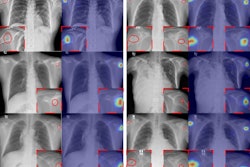A natural language processing (NLP)-based model using information from radiology reports can accurately identify patients presenting in the emergency department (ED) with suspected pulmonary embolism (PE), researchers have found.
The study results could help clinicians determine appropriate treatment, wrote a team led by Krunal Amin, MD, of Duke University School of Medicine in Durham, NC. The group's findings were published March 2 in the Annals of Emergency Medicine.
"[Our work suggests that] a natural language processing-based clinical decision support tool … can identify patients presenting to the emergency department with low-risk PE as candidates for outpatient management," it noted.
Diagnosis of acute PE tends to be made with a PE-protocol CT pulmonary angiogram (CTPA); preliminary findings from this exam are reported by a radiologist via a free-text report. Previous research has shown that using NLP algorithms with these unstructured reports is more effective for identifying PE than using administrative diagnosis codes, Amin's team explained, so the group developed and validated an NLP-based clinical decision support tool that could automatically flag patients presenting to the emergency department with low-risk PE and thus identify candidates for safe outpatient management.
The study included data from 12,183 individuals who underwent a PE-protocol CTPA in the emergency department between June 2018 and December 2020. Reports from these exams were categorized as positive or negative for PE, then divided into development, internal validation, and temporal validation cohorts to train, test, and validate a natural language processing model that could identify PE based on unstructured text. The investigators gathered risk stratification, patient- and encounter-level data from the electronic health record and used these data to calculate a simplified pulmonary embolism severity (sPESI) score at the time of PE diagnosis.
Amin and colleagues found that, across all the cohorts, 10.5% of studies were positive for PE. Of these, 22.2% were classified as low-risk.
The team also reported that the natural language processing model performed well when it flagged the presence of PE from a radiology report in the internal and temporal validation cohorts.
| Natural language processing model performance for identifying PE from radiology reports in internal and temporal validation cohorts | |
|---|---|
| Measure | Finding |
| Area under the receiver operating curve | 0.99 |
| Sensitivity | 86% to 87% |
| Specificity | 99% |
The study indicates that an NLP-based model using radiology reports and an automated risk stratification score can accurately identify patients with low-risk PE as candidates for outpatient management, but more research is needed to determine how it would actually integrate into clinical practice, according to Amin's team.
"Implementation of this tool as a part of a broader workflow that notifies clinicians of discharge candidates and ensures prompt outpatient follow-up has significant operational and clinical ramifications, particularly in the context of the ongoing issues with ED capacity," it concluded.
The complete study can be found here.



















